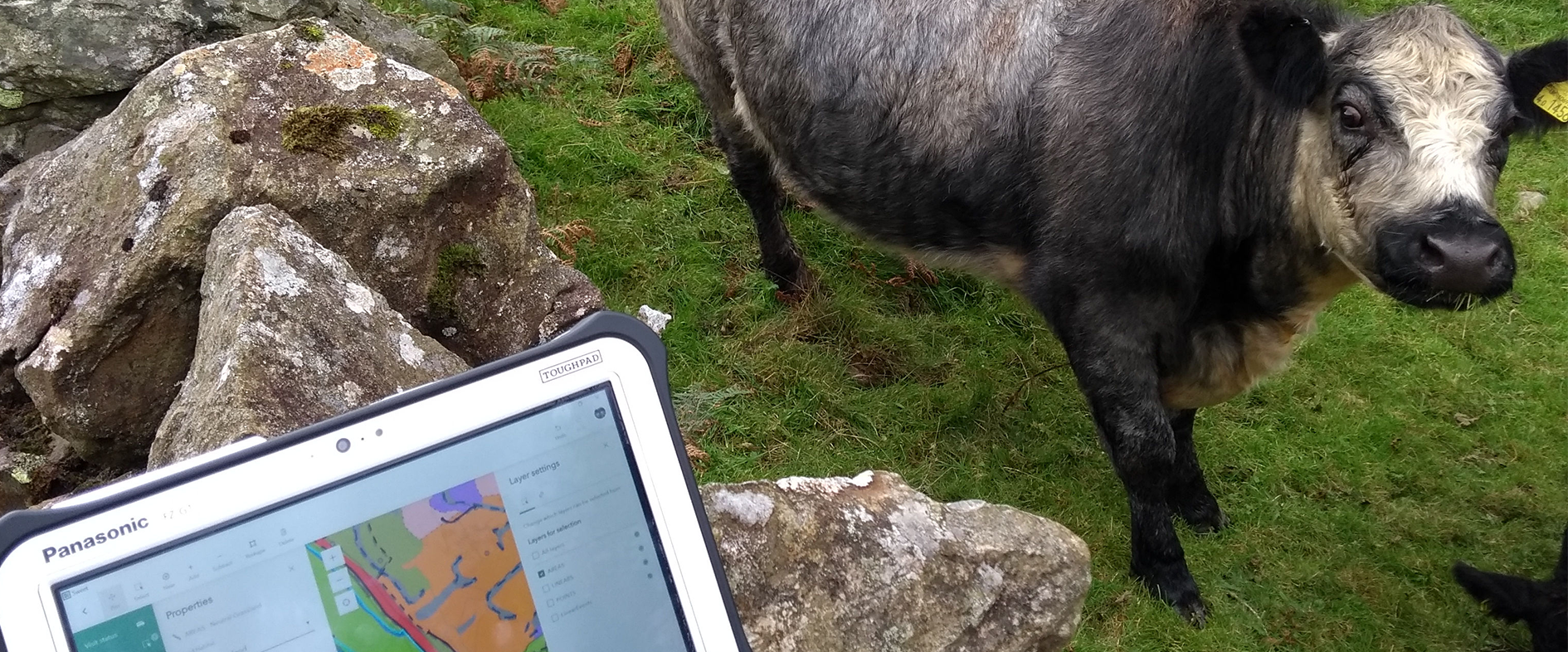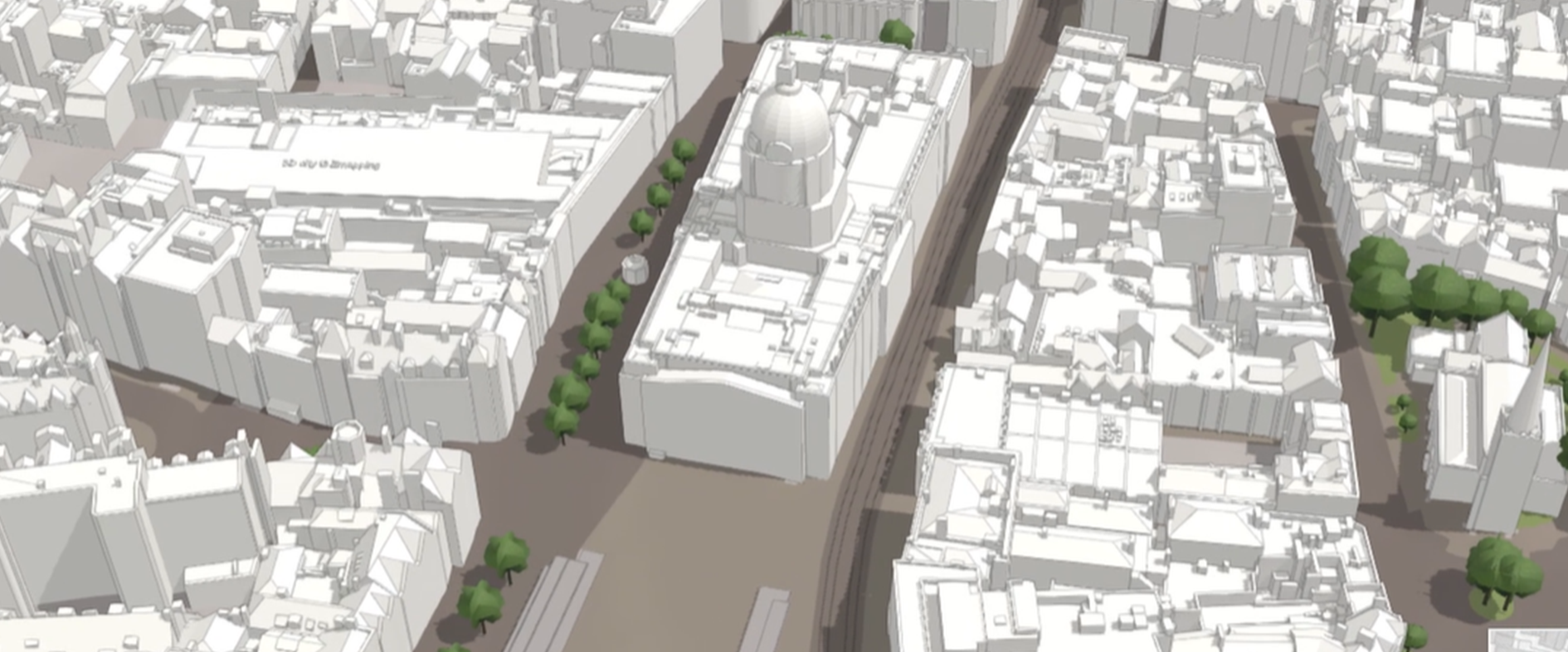Blog Archives
Post navigation

Denbighshire County Council
We are improving biodiversity in North Wales, using mobile apps to help us find, propagate and plant native flowers and trees.
In a highly successful conservation programme in Wales, Denbighshire County Council is using ArcGIS to improve the biodiversity of roadside verges and urban meadows. It has configured three integrated mobile apps with ArcGIS Survey123, which are helping biodiversity officers to find, propagate and plant some of the UK’s rarest native species of wildflowers and trees.
Up to 12 site surveys can be completed daily using ArcGIS Survey123 app in the field
Return on investment in ArcGIS Online subscription probably achieved within first three weeks of survey season, each year
10,000+ plants recorded consistently and accurately in ArcGIS in first three years
The Challenge
Since the 1930s, wildflower meadows have declined by 97% right across the UK and, in Wales, several native wildflowers including the Spreading Bellflower are at risk of extinction. Recognising the urgent need to expand wildflower environments in Wales, Denbighshire County Council protected 1,820 km of roadside verges from over-frequent cutting, created 11 roadside nature reserves and established 140 urban meadows, covering more than 70 acres of land.
The council knew, however, that simply creating these spaces for wildflowers would not, alone, lead to a reversal in biodiversity loss. It had to proactively collect seeds from local trees and wildflowers, grow plants and plant out the seedlings in the new habitats that it had created, to enable the recovery of endangered native species.
“Our ArcGIS Online subscription probably pays for itself within the first three weeks of each survey season.”
Liam Blazey, Biodiversity Officer, Denbighshire County Council
The Solution
To support this ambitious biodiversity enrichment programme, Denbighshire County Council created three integrated survey apps, configured using Esri’s ArcGIS Survey123 solution. Together, they make up a complete end-to-end process for managing everything from surveying verges and collecting seeds, to propagating seedlings and recording where young plants are planted out in the wild again.
The first app, called the Biodiversity Verge Monitoring App, allows biodiversity officers to collect data about sites monthly, during the growing season of March to August. Using a rapid grassland assessment technique, officers capture data about species present and the general condition of the land.
Next, biodiversity officers use the Plant Tracker App to record details about donor sites where seeds are collected and record the exact location of the donor flower or tree. Team members harvest seeds from across the county, and the app generates unique batch numbers, which are then written onto the seed envelopes.
The third app, the Nursery Propagation App, is used within the council’s plant nursery to label plant pots with batch numbers and monitor growing conditions, such as soil type and watering frequency. Nursery staff use the app to see details about each seed planted, including when and where it was collected and whether it is being nurtured in a polytunnel, on a raised bed or outside.
All data collected from the three apps can be viewed in ArcGIS Pro and ArcGIS Online and used to inform decisions about where to plant out seedlings. The council can also build ArcGIS Dashboards and ArcGIS StoryMaps to share data and explain the scale of the programme. “Showing people a map or dashboard so they can see how many acres have been rewilded or how many species have been transplanted, that’s where the impact is,” says Liam Blazey, Biodiversity Officer at Denbighshire County Council. “What ArcGIS allows you to do is phenomenal.”
“Our three ArcGIS apps give us complete traceability of all plant material from source to final destination, helping us to enrich our wildflower meadows with species native to northern Wales.”
Liam Blazey, Biodiversity Officer, Denbighshire County Council
Benefits
A fast and cost efficient survey process
If biodiversity officers had used paper surveys, then typed up the data and made the maps in the office later, they probably would only have surveyed one area a day. Instead, using the ArcGIS Survey123 app, they can survey sites in 20 to 90 minutes, depending on the size of the site, and complete as many as twelve surveys in a day. “Our ArcGIS survey apps allow us to get so much done, so quickly and still maintain scientific rigour in our process, which is critically important,” says Blazey. “Our ArcGIS Online subscription probably pays for itself within the first three weeks of each survey season.”
More successful propagation of trees and flowers
Using the data collected with ArcGIS, Denbighshire County Council can identify the best growing conditions to improve the success of its propagation processes, by seed type, and monitor the stratification of seeds. As Blazey explains, “We can look back to see which substrate and watering regime worked best in previous years and therefore improve the propagation success rate for the future. This project would not be remotely as far along the line as it is today without ArcGIS. ArcGIS is critical at every step for the success of this biodiversity project.”
The ability to trace plants and pathogens
Denbighshire County Council can trace the providence and origin of all the native plants that it has transplanted back into the environment using the data collected in ArcGIS. Consequently, if a pest or pathogen were to be detected in one plant, the council could easily find other plants originating from the same batch of seeds to help it maintain the health of the local countryside. “Our three ArcGIS apps give us complete traceability of all plant material from source to final destination, helping us to enrich our wildflower meadows with species native to northern Wales,” Blazey says.
Accurate, uniform data about native plant species
Through this programme, Denbighshire County Council is helping to increase the amount of accurate, dependable data about wildflowers and trees in North Wales. It shares its data from ArcGIS effortlessly with COFNOD, the North Wales Environmental Information Service, and works closely with other local organisations. “We have shared our ArcGIS apps with neighbouring councils, so more data on Welsh wildflowers is now being collected,” Blazey says. “As the data is uniform, more people can use it and more conservation work can come out of it.”

UK Centre for Ecology & Hydrology
From collecting data in the field to managing large-scale, nationwide survey projects, ArcGIS provides us with a highly efficient and accurate digital process for monitoring environmental change.
The UK Centre for Ecology and Hydrology (UKCEH) has completely transformed the way that it conducts field-based environmental research. Surveyors use a suite of ArcGIS data capture apps to collect high quality data more quickly, speeding up the delivery of reports, reducing survey costs and building up a clear picture of environmental change.
Surveyors use a selection of ArcGIS Online apps to collect environmental data in different ways in the field
All data and imagery collected is made instantly available in ArcGIS Online with no manual intervention or data entry
Managers oversee the progress of large, nationwide environmental surveys with ArcGIS Dashboards
The Challenge
An independent, not-for-profit research institute, the UK Centre for Ecology & Hydrology (UKCEH) is the UK’s centre of excellence for research in land and freshwater environmental sciences. It conducts independent research aimed at improving understanding of the natural environment and the impact that human activity has upon it.
For decades, environmental survey methods had largely remained unchanged. The Countryside Survey, for example, was first undertaken in the 1970s and, by the early 2000s, it still involved writing information on paper in the field and typing it up in the office afterwards. UKCEH wanted to completely modernise its approach to collecting environmental data in the field. It therefore set about creating a fully integrated, digital workflow for undertaking The Countryside Survey and other long-term monitoring projects more cost and time efficiently.
“Whether they are collecting soil samples, monitoring the presence of pollinators, recording plant species or editing woodland features, our surveyors use ArcGIS apps to collect accurate data, in a standard way, and work efficiently in the field.”
Claire Wood, Senior Geospatial Information Scientist, UKCEH
The Solution
UKCEH worked with geographic information system (GIS) specialists from Esri UK to develop a field-based, digital data capture approach, using mobile solutions from Esri’s ArcGIS system. First launched in 2007, this transformational new digital workflow enabled surveyors to collect environmental data in the field, on laptops and tablets, for the first time.
Since then, Esri UK has helped UKCEH to migrate to the latest ArcGIS Online apps and update its ArcGIS-driven survey method, making this digital process even better adapted to the challenges of collecting and sharing environmental data. Today, botanists use an ArcGIS Survey123 app to collect and accurately geo-reference soil samples and record around 1,200 plant species. Ecologists view environmental data in the field on ArcGIS Field Maps, while other surveyors use a mobile app configured with Sweet for ArcGIS to record changes to trees and landscapes.
Data collected in the field using ArcGIS is transferred digitally from mobile devices directly into ArcGIS Online without manual intervention or the re-entering of data. When field operations are completed, environmental experts from UKCEH use ArcGIS to help them analyse the data and present the results clearly in reports. An ArcGIS Online Dashboard gives the project team a clear overview of research projects, enabling them to closely monitor the progress of surveyors often working hundreds of miles apart.
UKCEH has used its ArcGIS-driven survey approach for successive Countryside Surveys, covering England, Scotland, Wales and Northern Ireland, as well as the Welsh Government’s Environment and Rural Affairs Monitoring and Modelling Programme (ERAMMP) and the Bunce Woodland Survey. The configuration of its ArcGIS apps and dashboards can be easily replicated for other UKCEH surveys in the future, saving time and minimising new project costs.
“The value of ArcGIS comes not only from the mobile data collection capabilities, but from the powerful back-end process.”
Peter Henrys, Statistician, UKCEH
Benefits
50% time savings in report generation
The use of ArcGIS has enabled UKCEH to dramatically reduce the time required to undertake environmental surveys. Indeed, the first time that ArcGIS was used for The Countryside Survey, UKCEH was able to produce the report in just one year, in less than half the time of the previous survey. “The value of ArcGIS comes not only from the mobile data collection capabilities, but from the powerful back-end process,” says Peter Henrys, UKCEH Statistician. “ArcGIS gives us a clear digital workflow for our survey data from the field right through to the publication of reports.”
Data ready for analysis 7 days faster
In the ERAMMP project in Wales, UKCEH estimates that the use of ArcGIS mobile solutions enables it to make data and imagery from the field available for analysis seven days sooner, giving it faster insight into emerging environmental trends. “All the data we need is in the database straight away, so we save at least a week of time per site, compared to the previous survey that was completed seven years ago,” explains Claire Wood, Senior Geospatial Information Scientist at UKCEH.
£700,000 cost savings on one survey alone
UKCEH no longer has to pay for collected data to be digitised, and this reduces costs significantly. Indeed, when the first ArcGIS-driven digital data capture process was introduced in 2007, the organisation calculated that it saved over £700,000 on one Countryside Survey alone. The cost of developing the original ArcGIS mobile solution was less than half of the cost of paying digitisers for twelve months. Since UKCEH migrated to ArcGIS Online solutions it has further reduced costs, as it no longer needs to make software updates.
Improved management of nationwide projects
The use of ArcGIS Dashboards enables UKCEH to monitor surveyors’ progress when they are working in the field. This real-time oversight helps it to manage large-scale, nationwide environmental research projects and deliver the evidence needed to inform national environmental policies on schedule. “We can make sure that progress is as it should be and pick up on any issues straight away,” Wood explains.
A high level of accuracy and data integrity
An added benefit of the ArcGIS approach is that it helps surveyors to collect data in a very consistent way. This leads to a high level of data integrity and accuracy in UKCEH environmental research. As Wood observes, “Whether they are collecting soil samples, monitoring the presence of pollinators, recording plant species or editing woodland features, our surveyors use ArcGIS apps to collect accurate data, in a standard way, and work efficiently in the field.”

City of Doncaster Council
With real-time, accurate data on litter collections and the condition of bins, we are improving the efficiency, quality and sustainability of our litter services.
City of Doncaster Council has freed up over 110 hours a year with a new ArcGIS-based workflow for managing litter collections. It is also reducing unnecessary journeys to minimise the council’s carbon footprint, while improving the quality of the litter collection service for local citizens.
Up to 4,000 assignments are assigned to council employees weekly with ArcGIS Workforce
Data is captured about the status of around 2,500 litter bins using ArcGIS Survey123
Supervisors make informed decisions about service improvements using ArcGIS Dashboard
The Challenge
In the South Yorkshire city of Doncaster there are around 2,500 litter bins on busy shopping streets, in quiet residential areas and throughout parks. Emptying these bins daily, weekly, or twice weekly, and maintaining their condition, is a major undertaking for City of Doncaster Council, involving seven teams and over a dozen vehicles.
For many years, council employees, known as bin runners, received a print out of the bins that they needed to empty in their area. The litter bins were not listed by location, making it easy for the bin runners to miss one or drive routes that were much longer than necessary. In addition, the council used to complete time-consuming, yearly audits of all its bins, to capture data about their condition and record any repairs needed.
“ArcGIS has given us the space and the capacity to look at other more strategic parts of the operation.”
Stefan Boodt, Street Scene Supervisor, Northwest Area, City of Doncaster Council
The Solution
The entire process for managing litter bins in Doncaster has now been completely transformed using a suite of solutions from Esri’s ArcGIS system. Instead of printing paper lists for bin runners, the Street Scene Team at City of Doncaster Council now uses ArcGIS Workforce to allocate up to 4,000 daily assignments to specific bin runners. Using ArcGIS Workforce on their mobile devices, the bin runners can sort the bins by proximity, enabling them to plan their routes more intelligently and reduce their drive times.
Integrated with ArcGIS Workforce is a mobile survey solution, created with ArcGIS Survey123, that allows the bin runners to capture data every time they visit a bin, including information on whether the bin is full, empty, damaged or overflowing. If trade waste is present, images can be taken and passed on to the council’s enforcement team. “Bin runners can complete the surveys in seconds, so it has a minimal impact on the time they need to empty their allotted bins in a shift,” explains David McDermott, Digital Spatial Developer at City of Doncaster Council.
Initially, bin runners also used an ArcGIS QuickCapture app to improve the accuracy of the council’s litter bin data in its asset management system. They could record bins that were not there, bins that were in different places or bins that were on the ground but not in the system. This app was used extensively in the first few weeks to improve street scene data, but is now rarely needed, as all bins have been verified.
Finally, the council has created an ArcGIS Dashboard, known as the Litter Bin Command Centre, which gives supervisors a real-time overview of litter bin collections and the data to inform changes to the service. As McDermott explains, “Our ArcGIS Dashboards give the Street Scene Team the opportunity to evidence its decision making, change the frequency of collections or install larger bins where needed. The dashboards also help supervisors to monitor and resolve issues, such as bins that cannot be emptied due to access obstructions.”
“Our ArcGIS Dashboards give the Street Scene Team the opportunity to evidence its decision making, change the frequency of collections or install larger bins where needed.”
David McDermott, Digital Spatial Developer, City of Doncaster Council
Benefits
Over 110 hours saved annually
By eliminating the need to conduct an annual audit, over 110 hours of staff time have been freed up every year, which can be spent on more value-adding activities to improve services. Thirteen people used to spend around nine days conducting the audit, during a six-week period, whereas now audit data is collected daily and is visible in real-time. “ArcGIS has given us the space and the capacity to look at other more strategic parts of the operation,” says Stefan Boodt, Street Scene Supervisor, Northwest Area, City of Doncaster Council.
Faster action to repair damaged bins
With the live capture of data, managers can see which bins have been emptied and which bins need repair, at any time. Equally, when local councillors report issues with bins, supervisors within the council’s Street Scene Team can look on the ArcGIS Dashboard, see which bin runner is nearest and quickly direct them to check the bin in question for damage, overflow or misuse. “ArcGIS makes our operations more streamlined,” Boodt says. “If a bin is damaged, we can action it significantly quicker.”
Reduced carbon footprint from lower mileage
Using the evidence collected with ArcGIS, the Street Scene Team can identify opportunities to reduce the frequency at which it empties bins and change bin types to eliminate unnecessary journeys and reduce the council’s carbon footprint. At one location, City of Doncaster Council has changed the type of bin collected by a specialist refuse collection vehicle (RCV) to a regular double bin which can be incorporated into an existing route. This avoids sending the RCV on a single 20-minute round trip, thereby saving around 260 miles of travel and eight and a half hours of bin runner time per year.
A better quality of service for citizens
Since the introduction of the ArcGIS-based system, the number of complaints about missed bins has been steadily declining because bin runners know exactly where to go. “In the city centre area, we used to get eight to twelve reports of missed bins per week, but now it is rare to even get one,” Boodt says. “We are experiencing similar improvements in other regions too and providing a better quality of service across the city than we were this time last year.”

NHS Fife
Managing our natural capital and meeting our sustainability responsibilities is so much easier with our ArcGIS Greenspaces Map.
In a quick and simple process, NHS Fife has mapped and classified all greenspaces across 45 separate hospital and healthcare sites using ArcGIS Online. It is now using its interactive Greenspaces Map to simplify its sustainability reporting, enrich biodiversity across its estate and introduce new wellbeing projects to benefit staff, patients and local communities.
130-hectare estate mapped and classified using Sweet for ArcGIS data collection web app
Data verified in the field with ArcGIS Field Maps app and displayed in ArcGIS Dashboard
Entire project completed in around six weeks with support from Esri UK
The Challenge
All public bodies in Scotland have a responsibility to protect and enrich biodiversity. The Nature Conservation Act (Scotland) 2004, and subsequent Wildlife and Natural Environment (Scotland) Act 2011, require public sector organisations to take care of the nature around them and produce publicly-available reports detailing the action they have taken to improve their natural capital.
Like all NHS Boards in Scotland, NHS Fife needed to fulfil this biodiversity duty and improve the management of its greenspaces. It has ten hospitals, as well as medical practices, midwifery units, community clinics and dental health centres throughout Fife, which together make up a 130-hectare estate. However, the organisation had neither an accurate map of its greenspaces nor a centralised record of whether its greenspaces were mown grass, wildflower meadows or unmanaged woodland. Without an accurate understanding of its natural capital, it was hard for NHS Fife to adapt the way it managed its greenspaces and meet the requirement for detailed biodiversity reporting.
“Esri UK has supported us in the creation of an incredibly detailed estates map that will significantly help us to identify areas of opportunity to manage our land in a more beneficial and sustainable way.”
Jimmy Ramsay, Head of Sustainability, NHS Fife
The Solution
With support from Esri UK, the estates team at NHS Fife used Esri’s ArcGIS Online to create a digital map of natural capital across all of the organisation’s 45 separate healthcare sites. “Esri UK guided us through the whole process,” explains Kathryn Hastie, Sustainability Officer at NHS Fife. “It was a really rewarding project to work on and only took about six weeks.”
Esri UK supported the configuration of an easy-to-use data collection app, using Esri’s Sweet for ArcGIS solution, which enabled two people, who were not GIS experts, to map every individual area of land very precisely. Through this process, each area of the estate – no matter how small – was classified using sixty different categories, such as garden, shrubs, grassland, woodland, building, path and car park. The organisation also recorded subcategories, enabling it to differentiate between different types of woodland or grassland.
A second mobile app, developed with ArcGIS Field Maps, allowed the students to make notes and take pictures while making site visits. In this way, they successfully verified the greenspace data in the map, building up a very detailed and accurate picture of the organisation’s natural capital. The team could also add supplementary data on features across the estate such as cycle racks, electric vehicle charging points and benches. “ArcGIS Online has given us such a clear view of the entire estate,” Hastie says. “We don’t just know where our greenspaces are; we also know exactly which type of greenspaces they are and what is nearby.”
The NHS Fife Greenspaces Map is now publicly available for anyone to view and is accompanied by an ArcGIS Dashboard that provides summary information. Both are used regularly by the estates and sustainability teams at NHS Fife for planning site maintenance, reporting on sustainability and informing new biodiversity enrichment schemes. The sustainability team also uses ArcGIS StoryMaps to share information about NHS Fife’s natural capital, promote conservation schemes and involve the local community.
“ArcGIS Online has given us such a clear view of the entire estate. We don’t just know where our greenspaces are; we also know exactly which type of greenspaces they are and what is nearby.”
Kathryn Hastie, Sustainability Officer, NHS Fife
Benefits
Accurate data to inform strategic planning and reporting
NHS Fife now has a complete and accurate picture of its entire estate, 62% of which is greenspace. The data from ArcGIS has proved invaluable for informing the organisation’s 2030 Greenspaces Strategy and meeting regulatory reporting requirements. “Our Greenspaces Map continues to drive our Greenspaces Strategy going forwards, highlighting ways that we can use our natural capital to benefit patients, staff, local communities and the planet as a whole,” says Jimmy Ramsay, Head of Sustainability at NHS Fife.
Optimum use of natural capital to improve wellbeing
Using the Greenspaces Map, NHS Fife is now putting in place plans to develop gardens and outdoor spaces where patients and staff can relax. At one hospital, for example, NHS Fife is planning a nature-rich garden suitable for patients with impaired mobility, close to the ward where they are treated. “As a healthcare provider, it is especially important for us to use our greenspaces to encourage people to get outside, enjoy the natural environment and improve their wellbeing,” Hastie says.
Expenditure reallocated to enrich biodiversity
NHS Fife can now use the Greenspaces Map to identify areas of grassland that can be converted into wildflower meadows, allowing budget previously allocated to grass cutting to be used to deliver new biodiversity projects instead. For example, at Lynebank Hospital, NHS Fife previously reduced grass cutting, enabling a new walking route, meadows and bird boxes to be introduced. As Ramsay says, “Esri UK has supported us in the creation of an incredibly detailed estates map that will significantly help us to identify areas of opportunity to manage our land in a more beneficial and sustainable way.”
Effective partnerships to benefit local communities
As part of its Greenspaces Strategy, NHS Fife plans to use its Greenspaces Map to work with partners, including Food4Fife and Rural Skills Scotland to identify suitable locations for community allotments, where groups can grow their own food, as well as training projects. The organisation’s ArcGIS StoryMaps showcase the success of current projects and will be updated over time to keep local people, staff, patients and other stakeholders informed about projects that will make the NHS Fife estate better for the environment and for the local community.

AECOM
In a challenging project to survey a hillside notorious for landslides, ArcGIS improved safety and efficiency.
Transport Scotland tasked infrastructure consulting firm AECOM with investigating landslide hazards across a remote Scottish hillside notorious for landslide-related road closures. AECOM used Esri’s ArcGIS to reduce the number of site visits required during the assessment and to better understand landslide behaviour in 2D and 3D.
Detailed watershed and catchment analysis completed on the desktop using ArcGIS Pro and specialist Esri Hydrology toolset
Clear 2D and 3D visualisations of site data available for all team members to explore on ArcGIS Online, providing a single project data source
Efficient mobile solution built with ArcGIS Survey123 to allow engineers to collect data quickly and consistently in the field.
The Challenge
In 2020, two major landslides caused the closure of the A83 Trunk Road in rural Scotland at a location known as The Rest and Be Thankful where the Trunk Road traverses a steep, southwest facing hillside along Glen Croe. Hillside stability after these major landslides was cause for concern.
Transport Scotland appointed AECOM to assess landslide potential and estimate landslide pathways and scale along Glen Croe. Well aware of the urgency of the project and the potential hazards faced when surveying unstable land in remote locations, AECOM needed to find a way to undertake the project as efficiently and safely as possible.
“We estimate that our use of ArcGIS reduced the number of site visits by at least 50%, which significantly reduced the risks from working at a remote, unstable site, as well as travel related risks traveling to and from site.”
Beth Mennie, Associate Director, Data, Geospatial and Analytics, AECOM
The Solution
AECOM had been using Esri’s ArcGIS for many years on this project and therefore decided to harness the 3D modelling and analytical capabilities of ArcGIS to help its Ground Engineering Team better understand the geography of the hillside.
First, the company used ArcGIS Pro to analyse the terrain in 2D and 3D to understand slope angle variation across the hillside, identify boulders, map historical debris source areas and locate tension cracks. It imported high resolution imagery of past landslip events to make comparisons and reveal patterns. Then it used the Esri Hydrology toolset in ArcGIS Pro to model watershed and flow paths to improve understanding of the terrain before site visits and 3D landslide modelling began.
In parallel, AECOM used ArcGIS Online to create a 3D web scene of the entire site, enabling the project team to visualise and virtually navigate the hillside. Specialist third party Rapid Mass Movement Simulation (RAMMS) landslide modelling software outputs presenting projected landslide trajectories, landslide velocities, landslide flow heights, rockfall bounce heights and rockfall energies, were also draped onto the ArcGIS Online map, allowing everyone to see the model calculations in context with surrounding features and terrain in 2D and 3D.
To support geologists working at the site, AECOM created a mobile data capture solution using ArcGIS Survey123. Several digital survey forms were built enabling geologists to record information such as boulder, rock outcrop and channel features, ground surface soil types and vegetation coverage. The geologists could add photographs as well as observations to their survey forms and record accurate, consistent, geospatially-referenced data. All the information collected in the field was uploaded directly to ArcGIS Online, making it instantly available to the whole project team. All ArcGIS project data was accessible electronically on tablets, allowing efficient cross referencing during the survey and avoiding the need to carry multiple drawings.
“Doing surveys with ArcGIS Survey123 is around five times faster than doing surveys on paper.”
Beth Mennie, Associate Director, Data, Geospatial and Analytics, AECOM
Benefits
Improved health and safety at a hazardous location
ArcGIS contributed to improved health and safety by enabling geologists to better understand hillside conditions, identify potential ground stability issues before going out on site and take necessary precautions to avoid areas of highest risk. Furthermore, the use of desktop surveys significantly reduced the need for repeat site visits and minimised the amount of time geologists needed to spend on site. “Reducing the number of field visits is an important aspect of improving health and safety and reducing travel-related carbon footprint,” explains Beth Mennie, Associate Director, Data, Geospatial and Analytics, at AECOM. “We estimate that our use of ArcGIS reduced the number of site visits by at least 50%, which significantly reduced the risks from working at a remote, unstable site, as well as travel-related risks traveling to and from site.”
Fivefold acceleration in field surveys
By using ArcGIS Survey123 for data collection, AECOM was able to dramatically improve the efficiency of its field-based operations by as much as 400%. It took advantage of smart editor tools to enable data collection to be undertaken consistently and created drop-down fields to speed up the process of surveying the hillside. “Doing surveys with ArcGIS Survey123 is around five times faster than doing surveys on paper,” Mennie says. “What is more, the data collected using ArcGIS Survey123 is more consistent, more detailed and more accurate which really makes a difference in the design and build phases.”
Well-engineered designs to mitigate risks
ArcGIS played a pivotal role in helping AECOM and Transport Scotland to identify sections of carriageway at risk of future landslide activity, estimate landslide scale and assess operational impact with less uncertainty. Landslide risk reduction measures designed to capture and retain debris, such as catch pits and catch fences, can therefore be designed more efficiently, reducing potential for under-design (where mitigations are not resilient enough to capture debris) and over-design (where mitigations are oversized offering poor cost efficiency). “The optimised design of catch pits and catch fences will reduce the number of road closures needed in future and minimise road user disruption,” Mennie says.
Effective collaboration throughout the project
The use of ArcGIS Online web maps gave the project team a better understanding of the site from the outset and enabled everyone to more easily visualise the site and share information. All survey data was visible in ArcGIS Online as soon as it was uploaded, and models from separate specialist systems were integrated into ArcGIS, creating a single place for all project information. This created a highly collaborative project within AECOM and, as Mennie says, “contributed to a good working relationship with our client, Transport Scotland, during project delivery too.”

Oxygen Conservation
In strikingly beautiful and unique landscapes across the UK, we are using ArcGIS to understand the potential of natural capital and measure the positive impact of conservation initiatives.
An organisation that is working to redefine and expand conservation across the UK is using Esri’s ArcGIS system to gain a deeper understanding of landscapes, habitats and species across a portfolio of land covering almost 30,000 acres. ArcGIS is helping Oxygen Conservation to evaluate the potential of natural capital, implement sustainable land management practices and measure the positive impact of its environmental programmes.
Employees, stakeholders and partners visualise and share environmental information on ArcGIS Online data viewers
Senior managers evaluate natural capital potential with ArcGIS Pro and manage the entire land portfolio on ArcGIS Dashboards
Environmental impacts are measured with ArcGIS Pro and positive stories are shared in ArcGIS StoryMaps
The Challenge
Oxygen Conservation’s purpose is to deliver conservation at scale. By improving land management across large areas of the UK, the organisation’s founders aim to deliver positive environmental and social impacts, while also achieving a profit for investors as a result of what they do, not the purpose. It currently owns and manages ten sites in Scotland, England and Wales, covering a total area of almost 30,000 acres. Each of its sites has a different mix of land types and habitats and therefore presents different land management challenges.
Oxygen Conservation commissions a wide variety of surveys and studies to gather ecological, environmental and financial data for each of its sites. The organisation needed a space in which it could collate this information, review it and share it with both internal and external parties. Most importantly, however, it needed to be able to visualise its sites and monitor change over time to help it clearly demonstrate its positive impact across a diverse range of landscapes.
“ArcGIS enables us to show the changes that have occurred and the impact we have made to improve things for the future.”
Lara Salam, GIS and Data Visualisation Expert, Oxygen Conservation
The Solution
Lara Salam was appointed as Oxygen Conservation’s first-ever data visualisation expert and quickly set to work creating a range of solutions using Esri’s ArcGIS system. She started by using ArcGIS Pro on the desktop to consolidate in-house data, as well as third-party data on habitats, landscape features and boundaries from Esri UK’s Premium Data Services and the Esri Living Atlas of the World.
Harnessing the flexible capabilities of ArcGIS Online and ArcGIS Experience Builder, Salam then created a custom web application for each of Oxygen Conservation’s sites, known internally as data viewers. Styled consistently with the organisation’s branding, these data viewers enable employees, partners and stakeholders to see a vast amount of information, in one location, on one interactive map of the site. This data includes footpaths, habitat layers, biodiversity scores, water quality and river networks.
From these first steps, the use of ArcGIS within the organisation has continued to evolve. Now, senior managers use an ArcGIS Dashboard to maintain a high-level understanding of the organisation’s complete land portfolio. This dashboard provides a live overview of the number of sites under management, the amount of money invested, the size of tree planting areas and a bar chart showing the range of habitats.
Oxygen Conservation is beginning to create ArcGIS StoryMaps too, to help employees to share information about their vision for sites with a wider audience. They are incredibly excited to soon be sharing this data on certain areas of their website for others to see and further understand the plans for each site through visual demonstration. One recent StoryMap explains what Oxygen Conservation plans to do on Exmoor, as part of a joint venture with a family of farmers, who have lived on the land for generations. “ArcGIS StoryMaps are a really effective way to share a story about a particular site or scheme,” Salam says.
To support its planned expansion, Oxygen Conservation also uses automation tools in ArcGIS Pro, including ArcGIS ModelBuilder, to build geoprocessing workflows for evaluating land parcels that are for sale and gathering data to inform investment decisions. Then, whenever a new site is acquired, a new ArcGIS data viewer can be created specifically for it, very quickly, by replicating the organisation’s existing data viewer templates.
“Scaling up our use of GIS is helping us to scale conservation.”
Lara Salam, GIS and Data Visualisation Expert, Oxygen Conservation
Benefits
Deeper understanding of conservation at scale
The online data viewers that Oxygen Conservation has created with ArcGIS give employees a deeper understanding of complex and precious environments across large sites, at multiple locations throughout the UK. Everyone can get the information they need, from any internet-connected device, wherever they are working. At Esgair Arth in Wales, the ArcGIS data viewer has helped Oxygen Conservation to visualise and appreciate the unique valley setting of an ancient woodland and plan a conservation scheme to support the sustainable regeneration of this beautiful area.
Effective monitoring of environmental change
ArcGIS provides an effective and highly visual way for employees at Oxygen Conservation to track their progress over time and demonstrate the positive impact they are initiating on the environment. At the 11,000-acre Invergeldie estate in Perthshire, Scotland, for example, Oxygen Conservation will use ArcGIS to show where peatland restoration and tree planting will occur. “ArcGIS enables us to show the changes that have occurred and the impact we have made to improve things for the future,” Salam says. “Future generations will be able to walk through the woodlands we have created and appreciate the species we have helped flourish through the improvement habitats and those we have reintroduced.”
Improved transparency and collaboration with stakeholders
For many projects, including the 400-acre Wood Advent Farm in Devon, Oxygen Conservation uses its ArcGIS data viewers to share information openly with stakeholders and partners. With access to the same, up-to-date data, all partners involved in the regeneration of Wood Advent Farm are able to work collaboratively to transition to organic food production. “Our stakeholders are often very invested in the landscape,” says Salam. “ArcGIS enables us to share information with them and be transparent about our future plans.”
Well-considered expansion of ethical business
By enabling Oxygen Conservation to evaluate the natural capital of land parcels that are for sale, ArcGIS is playing a key role in helping the organisation to achieve its goal of significantly growing the acreage under management within two years. “Scaling up our use of GIS is helping us to scale conservation,” Salam says. “ArcGIS helps us to understand the natural capital potential of sites, identify areas where Oxygen Conservation can add value and determine how much positive change we can make in different environments.”

Hertfordshire County Council
We have revolutionised delivery and coordination of our highways improvement and management schemes by using ArcGIS Enterprise to create a central Virtual Operations Hub, supporting collaboration across multiple teams.
Hertfordshire County Council is taking a ‘one and done’ approach to the management of its highway schemes. Using ArcGIS Enterprise it has developed a Virtual Operations Hub enabling different teams to collaborate and coordinate works, minimising road closures and reducing costs.
£60,000 cost savings alone from cancelling schemes with coordinated schemes optimising resources
Newly coordinated schemes vastly reduce gridlock, congestion and the impact on local communities
More efficient collaboration across disparate teams supports both immediate needs and longer-term planning
The Challenge
Hertfordshire County Council (HCC) is responsible for over 5,000km of highway network and its Highways Transport Planning and Data Team (HTPD) constantly strives for improvement in service delivery through objective analysis, openness and transparency.
There are hundreds of improvement and maintenance schemes being planned or undertaken on the network at any given period, all of which are generated through a variety of pathways. Highways engineers need to be aware of all these schemes and programmes of works, from emergency work, and gully cleansing to resurfacing, in order to identify co-ordination opportunities. However knowledge was not easily sharable, coordination was difficult and opportunities to optimise resources were potentially missed. Data was held in isolated silos, on different platforms, and there was no single tool to give context to the data and offer any useful interpretation. Knowledge also remained with individuals and was not always recorded.
The HTPD team was asked to investigate how a new collaboration tool could support the ‘one and done’ approach. HCC already had internal web maps for asset management purposes and user groups including district service agents, contract managers; but what did they want to see?
The HTPD team acknowledged it was vital to support project coordination to save time and costs. “The web app was the easy bit. The difficult part was understanding where the data was stored and getting information out of people’s heads,” observed Antony Oldridge, Team Leader/Principal Analyst, Transport Planning & Data Team, Environment & Transport, Hertfordshire County Council.
“The Virtual Operations Hub supports all highways staff by making the information visible on a map, so they can identify opportunities to join up work, visualise clashes and so generate efficiencies.”
Antony Oldridge, Team Leader/Principal Analyst, Transport Planning & Data Team, Environment & Transport, Hertfordshire County Council
The Solution
The Virtual Operations Hub is a live web app developed in partnership between HCC, WSP Arup and Ringway Infrastructure Services. It contains work HCC is planning to do on the network, schemes being considered for following years, completed schemes alongside customer reported defects and enquiries. Data is shared between all parties within the Hertfordshire contract.
Experienced in the use of ArcGIS Enterprise, the HTPD team began by using ArcGIS Desktop to prepare the data layers and undertake clash detection. Data is extracted and published in ArcGIS Online, visualised on one digital map letting users instantly see commonalities, view data they did not previously have access to and combine datasets to understand spatial and temporal relationships.
Currently (as of March 2023) its 27 data layers, automatically updated, include contextual information such as planned housing, flood risk areas and HCC’s ideas pool of potential schemes to help mitigate the effects of growth and encourage active travel. Several layers are automatically updated overnight with Ringway contributing its own data. Access for Ringway teams is through a shared, secure HCC portal account using Citrix to access the dynamic landing page.
Internal training for colleagues is being rolled-out across user group meetings, so specific teams can see how their requirements are being met. Individuals from these teams now access the Virtual Operations Hub to view and query data in order to look at collaboration opportunities.
“Our highways schemes are now joined and we can also think more strategically longer-term so, if we need to build something, we will build it once, and build it right.”
Gary Beaumont, Transport Planning & Data Manager, Hertfordshire County Council
Benefits
Preventing gridlock and reducing congestion
Co-ordinated works support HCC’s ‘one and done’ approach by minimising road closure times, maximising the use of road space and reducing the impact on local residents and businesses. Related works such as sign-cleaning, hedge trimming and gully cleaning can now be undertaken while a resurfacing scheme is taking place. In 2022/23, HCC co-ordinated 379 out of 1874 schemes, into 49 separate coordination areas.
Better decision-making driving down costs
The Virtual Operations Hub is helping HCC to save money and reduce costs to society, by minimising congestion and disruption. Detailed evaluation of planned schemes enables decision-makers to assess needs and make decisions on whether to proceed more accurately. HCC has already identified six schemes to merge, defer, and coordinate so far in 2023 which would have cost approximately £60,000.
More efficient collaboration supporting community engagement
Highway Locality Officers now use the Virtual Operations Hub when liaising with County Council members and communities; readily available information allows them to inform, engage and make intelligence-led decisions on, for example, cycling and walking infrastructure plans.
Enhanced longer-term planning aids understand
The Virtual Operations Hub contains future ideas and mitigation schemes that have been generated from highway modelling, and strategy documents like the Local Cycling Walking and Infrastructure Plans (LCWIP) and the growth and transport plans. Strategy Managers can see growth and potential schemes, enabling them to plan for possible larger interventions and understand the possible lifetime of current works.
Improved service delivery for communities
Data from cyclic work such as gully cleansing is viewed live from site crews enabling the drainage community to understand the context of flooding enquiries. Routine works and highways enquiries such as road degradation reports are mapped, so managers can more easily understand the history of the road section and any potential clustering of issues. These can be used to inform priority works planning where, for example, road conditions have worsened.

Nottingham City Council
We have created a highly-detailed, city-sized digital twin of Nottingham and are proud to be sharing our experiences with others.
Nottingham City Council has created an immersive, interactive and highly-detailed 3D model of the entire city to support development planning. This advanced digital twin enables planners to understand proposed new developments more easily, have more interactive discussions with developers and accelerate the planning process.
The large-scale, 3D digital twin of the city of Nottingham was created using ArcGIS Online and is hosted in the cloud
Nottingham City Council has received government funding to help other UK planning authorities use 3D modelling
Esri UK’s Professional Services team helped the council to deliver the digital twin and optimise the use of 3D data
The Challenge
Nottingham City Council was an early pioneer in the field of 3D urban planning. It began to use digital 3D modelling techniques nearly 20 years ago, primarily for long-term strategic planning and major regeneration schemes. As demand for 3D visualisations grew, the council realised that it needed to replace its desktop software with a more flexible, web-based approach, and it started to explore the 3D capabilities of Esri’s ArcGIS system.
First the council developed a couple of lightweight public applications using ArcGIS, including an app for helping tourists to discover and appreciate the vast network of caves that lies beneath the historic city centre. Soon, though, a bold ambition arose to create a detailed 3D digital twin of the entire city, covering more than 73 square kilometres and depicting thousands of historic and modern buildings, open spaces and infrastructure.
“We have successfully fused together traditional 2D planning information with a state-of-the-art 3D GIS environment, to create a single, comprehensive digital twin of the city of Nottingham.”
Mick Dunn, GIS Service Manager, Nottingham City Council
The Solution
Building on its prior experience, using its existing ArcGIS licenses and leveraging its accumulated knowledge and 3D data, Nottingham City Council created an extensive and immersive 3D cityscape that could be accessed and shared via the Internet. It developed this digital twin using ArcGIS Online, hosted in the cloud, receiving support from Esri UK’s Professional Services team to create the pilot solution and optimise the generation of 3D data at Level of Detail 2 (LoD2).
Far more than just a 3D model, the citywide digital twin embeds and visualises a vast amount of contextual information, including 2D data on conservation areas and flood plains, and street-level videos from CCTV cameras. The solution also includes a 3D photo-realistic mesh from Bluesky and live traffic data, both of which are streamed directly from Esri's Living Atlas of the World.
The Nottingham City Digital Twin is now used for site assessments and is fully embedded within the council’s pre-application planning process. When developers submit planning proposals, their plans and Building Information Modelling (BIM) files are incorporated directly into the digital twin. Planners can then click on different points on the 3D city map to visualise the proposed new street views, see potential constraints and identify other issues that might present planning concerns.
In recognition of the enormous value that can be gained from the use of urban digital twins, Nottingham City Council has now received government funding, from the Department of Levelling Up, Housing and Communities PropTech Innovation Fund, to develop this capability further to drive public engagement, and help other UK Local Planning Authorities establish 3D capabilities. With support from Esri UK, it will be creating demonstrators, learning resources and tools that other councils can leverage to develop their own digital twins and transform their planning processes cost-effectively.
“We are proud to be leveraging our investment in Esri technology and maximising the value of our existing 2D data in a 3D environment to modernise the planning process and increase user engagement.”
Mick Dunn, GIS Service Manager, Nottingham City Council
Benefits
A single source for all planning information
For the first time, Nottingham City Council’s planners can see all the information they need relating to the pre-planning application process in a single GIS application. Whether they need information on flood risks, listed buildings or traffic congestion—relating to a residential development in Mapperley Park or an office block in Lace Market—everything is visible in a highly-detailed, city-sized digital twin. “Our 3D, ArcGIS model of Nottingham is a UK first, in terms of the level of detail that it delivers and the size of the urban area that it covers,” says Mick Dunn, GIS Service Manager at Nottingham City Council. “We have successfully fused together traditional 2D planning information with a state-of-the-art 3D GIS environment, to create a single, comprehensive digital twin of the city of Nottingham."
Quicker decision making in planning process
Using the Nottingham City Digital Twin, planners can now make faster, well-informed decisions about the potential impacts of new developments on the city’s distinctive character and skyline. “Having this tool allows planners to understand proposals better,” explains Dunn. “Planning proposals can therefore be approved faster, allowing construction to start sooner and developers to realise their commercial goals more quickly.”
Improved transparency and engagement
Planners can use the Nottingham City Digital Twin in meetings with developers to improve the transparency of the planning process and support interactive discussions about any modifications that need to be made to plans. In addition, the digital twin can be used by members of planning committees to make complex information clearer and improve understanding of the impacts of new developments. “The next logical step is to make the Nottingham City Digital Twin publicly accessible, to improve transparency with everyone, which is what we are planning to do soon,” shares Dunn.
Greater ROI from ArcGIS and 2D data holdings
Dunn is justly proud of Nottingham City Council’s achievements and recognises that the development of the Nottingham City Digital Twin has significantly increased the return on investment that the council gains from ArcGIS licenses and staff training. The digital twin has given the council an exciting new platform, based on familiar technology, that can be used as the foundation for other value-adding planning tools in the future. “We are proud to be leveraging our investment in Esri technology and maximising the value of our existing 2D data in a 3D environment to modernise the planning process and increase user engagement,” Dunn concludes.

Jurassic Fibre
We have put ArcGIS at the heart of our business to help our teams collaborate effectively and accelerate the rollout of ultrafast broadband.
The telecoms company Jurassic Fibre uses Esri’s ArcGIS system to build, validate and share a trusted digital twin of its actual and proposed broadband network. This digital twin provides over 460 employees, from surveyors and planners to construction engineers and sales people, with a single version of the truth that they can depend on for real-time decision-making.
Surveyors and construction teams use ArcGIS mobile apps to view, collect and validate network data in the field
Planners and designers use ArcGIS web apps and tools to devise the optimal roll-out plans for new broadband networks
Senior managers monitor live information on the status of build projects and sales on ArcGIS Dashboards
The Challenge
Jurassic Fibre was founded in 2018 with the aim of bringing full fibre, ultrafast broadband to digitally-deprived areas of South West England. As a brand new, start-up business, it needed a complete suite of solutions that could be deployed quickly to support end-to-end business processes, from network planning and design to construction and sales. Esri’s ArcGIS system met this requirement perfectly, providing out-of-the-box applications and tools that could be easily configured to support the new company’s preferred ways of working across all business teams.
“ArcGIS offers that complete package of field, mobile, desktop and online apps and displays.”
Gemma Malone, GIS Data Quality Assurance Manager, Jurassic Fibre
The Solution
Jurassic Fibre selected ArcGIS Enterprise and deployed this foundational software in the cloud on the Microsoft Azure platform. It then steadily rolled out a succession of ArcGIS solutions to support all of the company’s 460 employees, across every team and business function. There are also 30 ‘super users’ in GIS, IT and planning teams who manipulate geospatial data and use the ArcGIS system intensively.
When Jurassic Fibre identifies a new target area for the roll-out of ultrafast broadband, existing address and telecoms infrastructure data is loaded into the ArcGIS Enterprise database to give the company’s surveyors a starting point. The surveyors then use the ArcGIS Field Maps app on mobile devices to view this information in the field, collect additional information and mark potential broadband network routes on maps. All of this information is fed directly into ArcGIS Enterprise creating a rich digital twin of Jurassic Fibre’s existing and planned telecoms network.
Back in the office, designers use the ArcGIS digital twin to inform their network designs; planners view the digital twin to organise construction; and the construction team views the same digital twin on mobile devices during the build phase to manage activities on site. All departments within Jurassic Fibre have discrete mapping apps, giving them precisely the functionality they need, as well as their own ArcGIS Dashboards allowing them to track their progress against targets.
Jurassic Fibre particularly appreciates the ease at which geospatial data can be shared with different groups of users, in real time, and transferred seamlessly between its many ArcGIS apps, dashboards and solutions. “ArcGIS offers that complete package of field, mobile, desktop and online apps and displays,” says Gemma Malone, GIS Data Quality Assurance Manager at Jurassic Fibre. “Pretty much every part of the business uses ArcGIS to some extent, whether this is updating maps, collecting data, creating designs or monitoring progress on dashboards.”
“For us, ArcGIS is a critical system of engagement that enables us to ensure that a single version of the truth is transferred and communicated to all teams, at once.”
Arindam Basu, Head of GIS and Inventory, Jurassic Fibre
Benefits
A single version of the truth
The primary benefit of ArcGIS is that it enables Jurassic Fibre to provide all employees with one trusted source of live data. Everyone can see the current situation, on any device, which is particularly beneficial downstream during the build phase. “For us, ArcGIS is a critical system of engagement that enables us to ensure that a single version of the truth is transferred and communicated to all teams, at once,” says Arindam Basu, Head of GIS and Inventory at Jurassic Fibre.
Effective internal communication and collaboration
As all teams are working from the same digital twin, they can communicate and collaborate highly effectively – whether they are installing fibre networks in rural Dorset, managing sales at the head office in Exeter or working in the technical team in Jamaica. “In an industry in which things change on a daily basis, having live maps and dashboards enables all employees to understand, monitor and communicate what is going on in the network,” Basu says. “ArcGIS is the heart of the whole business.”
20x faster business workflows
Jurassic Fibre has recently used ArcGIS to create a new mobile process, enabling surveyors and other employees working in the field to verify the ‘as-built’ infrastructure from their mobile devices, by just clicking on assets on digital maps on their mobile devices. Any assets that are not shown correctly can be flagged and records updated quickly. “The as-built verification process is at least 20 times faster than before,” explains Kimani Williams, Senior GIS Map Developer at Jurassic Fibre, “plus we are capturing much more data through this approach, which is enabling us to improve the accuracy of our digital twin.”
High quality service for customers
Using its ArcGIS mobile and web-based solutions to capture and edit data on a daily basis, Jurassic Fibre is now constantly improving the quality and accuracy of its digital twin. This is important because the more accurate the digital twin becomes, the less likely it is that unexpected issues will be encountered at the installation phase. Consequently, the company can avoid unnecessary delays in customer installations and provide a high quality service for customers.
Rapid roll-out of broadband network
The single version of the truth, the improved collaboration and the streamlined processes, that have all been achieved with ArcGIS, help Jurassic Fibre to accelerate the delivery of ultrafast broadband and optimise revenues. “ArcGIS definitely helps us to roll out our fibre network at a faster pace than we would be able to do otherwise,” Malone says. “ArcGIS also helps us to more accurately calculate build costs and understand business opportunities that exist within our expanding network.”

Ramblers Scotland
ArcGIS Hub Premium is helping us to engage the support of 250 volunteers and share information about Scotland’s 40,000 mile network of walking paths.
Ramblers Scotland has created the nation’s most comprehensive interactive map of walking paths using ArcGIS. Now, hundreds of volunteers throughout Scotland are auditing the condition of these trails using ArcGIS Hub Premium and gathering up-to-date information that the charity can use to encourage more people to discover the joy of walking.
Around 40,000 miles of paths are now visible for the first time on a single, interactive map of Scotland, powered by ArcGIS
Hundreds of miles of paths have been mapped for the first time by layering diverse data sets in ArcGIS and integrating local knowledge
8,600 trails have been audited by 250 volunteers using the easy-to-use functionality and templates in ArcGIS Hub Premium
The Challenge
Ramblers Scotland is a walkers’ charity that works to protect and promote access rights and inspire people to spend time walking for pleasure. It recognises that walking is a very powerful activity that can improve health and wellbeing, as well as create wonderful memories for families and friends to share.
One of the charity’s key missions is to make information about Scotland’s paths easily available to everyone. However, there wasn’t a single, unified source of data about Scotland’s entire path network. Luke Phillips, Project Manager at Ramblers Scotland, explains, “There are lots of places where you can walk in Scotland, but there were not necessarily the resources available to show people where they could actually go.”
“This is the best ever map of Scotland’s trails, and it’s only going to get better as we expand and refine the data in the years to come.”
Danny Carden, Communications Manager, Ramblers Scotland
The Solution
Setting out to address this challenge, Ramblers Scotland first used Esri’s ArcGIS software to bring together a wide range of datasets about Scotland’s paths, from multiple sources. Very soon, a comprehensive picture of all the trails in Scotland began to emerge, from remote mountain passes to pushchair- and wheelchair-accessible paths in town and city centres.
Then, using ArcGIS Hub Premium, Ramblers Scotland set up a community hub that would allow volunteers and community groups to submit local knowledge about paths, walk along local routes, gather data about the condition of paths and upload this information. The charity has over 250 volunteers from the Shetland Islands to Dumfriesshire. Using out-of-the-box functionality and templates, it was able to create a straightforward process for submitting data and images, that was very simple for volunteers of all ages and backgrounds to use and easy to scale up in the future.
The initial test run of ArcGIS Hub Premium took place in the west of Scotland, using path data amalgamated from around twelve different sources. This trial enabled the project team to see what the new ArcGIS-based paths map would look like and understand the role that volunteers could play in auditing paths. “The results were amazing,” says Danny Carden, Communications Manager at Ramblers Scotland. “We couldn’t believe how many hidden trails suddenly emerged from the data. The test gave us confidence to go further across the nation.”
“I’m really proud to have worked on this project, because we’ve taken an idea and built it into something that’s really big and growing that will benefit the whole country, helping people get outdoors and be more active.”
Luke Phillips, Project Manager, Ramblers Scotland
Benefits
A single paths map for Scotland
Powered by ArcGIS, the Scottish Paths Map is now live on the Ramblers Scotland website, enabling anyone to zoom into a specific area and find new trails to explore. The Scottish Paths Map currently shows around 40,000 miles of paths including many that are not shown on Ordnance Survey maps. In the first month alone, the Scottish Paths Map attracted in excess of 30,000 visitors, demonstrating just how valuable a resource this is for people living in and visiting Scotland. “This is the best ever map of Scotland’s trails, and it’s only going to get better as we expand and refine the data in the years to come,” says Carden.
New paths revealed for people to enjoy
By using ArcGIS to combine all known data sets about paths, from many different sources, Ramblers Scotland discovered hundreds of miles of paths that it had not previously been aware of. “So far, the data has revealed tens of thousands of miles of paths and we’ve gathered possibly two to three thousand additional miles through volunteer participation,” says Phillips. “I’m really proud to have worked on this project, because we’ve taken an idea and built it into something that’s really big and growing that will benefit the whole country, helping people get outdoors and be more active.”
Routes easily audited by volunteers
The community hub created using ArcGIS Hub Premium is very easy for people to use, without training or technical knowledge. Consequently, almost everyone who enjoys walking can get involved in auditing trails and use ArcGIS to collect high quality data that Ramblers Scotland can then refine and share. “We wanted to share Scotland’s path network with more people, and the best way to do that was to create an inclusive tool that our volunteers could populate themselves,” says Carden. “Using ArcGIS Hub Premium, we have been able to create a really easy-to-use and straightforward tool for volunteers.”
Positive engagement with communities
Since implementing ArcGIS Hub Premium, Ramblers Scotland has successfully audited 8,600 paths, covering many thousands of miles. “The numbers are really impressive, but what’s really encouraging for us is how we’ve inspired communities to start recording their path networks, and auditing and sharing them with others, so more people right across Scotland can get active on foot,” Carden says. “Our whole purpose is to link communities, so the idea that we are getting volunteers out on the ground through ArcGIS to make that happen is hugely encouraging.”


